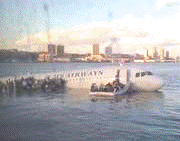Bird Strike Committee Proceedings

Bird Strike Committee-USA/Canada Joint Annual Meeting: 10th (2008)
Date of this Version
8-2008
Document Type
Article
Abstract
The osprey (Pandion haliaetus) is one of the most widely distributed and well studied bird species of the Northern Hemisphere; however, little is known about their potential impacts to military flight operations. A Department of Defense, Legacy Natural Resources Program-funded multi-agency research project examining the strike-risk posed by breeding and migrating Osprey was initiated in 2006. During the 2006 and 2007 nesting seasons, a total of 13 adult Osprey were live-captured, fitted with GPS-capable satellite transmitters, and released from selected nest locations near Langley Air Force Base, Virginia, in the Mid- Atlantic Chesapeake Bay Region. We monitored satellite-tagged Osprey movement and activity patterns by tracking them during the breeding, migration, and wintering periods. Movement information collected from breeding Osprey was cross referenced to Langley Air Force Base flying operations to assess the risk breeding Osprey pose to military aircraft near the airfield. During the breeding season, adult Osprey flew at an average altitude of 63 m above the ground and were flying relatively equally throughout daylight hours. In addition, migratory patterns of Osprey were evaluated to assess the risk migrating Osprey to military aircraft operations along the Eastern seaboard. All adult Osprey utilized similar migration routes along the eastern coast of the United States. Female Osprey began their fall migrations (August), prior to males (September). Adult Osprey migrated (moved) during daylight hours and roosted at night. During migration, females flew at an average altitude of 377 m and males flew at an average altitude of 324 m. Incorporation and integration of Osprey movement information (e.g., timing, travel routes, altitude) into military flight mission planning systems will increase pilot awareness of potential Osprey-aircraft strikes during critical time periods and will allow for military flight operations to occur at times and locations that minimize the risk of Osprey aircraft collisions.


Comments
Abstract of poster presentation at Bird Strike Committee USA/Canada Meeting, Lake Mary and Sanford, Florida, August 18–21, 2008.